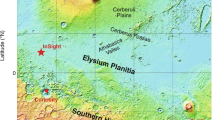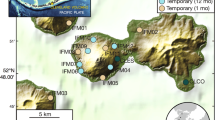Abstract
The network of seismographs on Earth allows us to gather enough data to reveal the properties of the metallic core hidden in the centre of the planet’s mantle envelope. In contrast, the small number of seismographs deployed on the Moon or Mars limits the sampling of their interiors and makes inferences challenging. Here we show that a single seismograph and global-scale waveform cross-correlations between seismic events can be used to scan planetary cores. We demonstrate that this technique allows us to constrain the sizes of the cores of Earth and Mars and we confirm that the Martian core is large. This technique provides an opportunity to investigate the structure of planetary interiors with currently realizable resources.
This is a preview of subscription content, access via your institution
Access options
Access Nature and 54 other Nature Portfolio journals
Get Nature+, our best-value online-access subscription
$29.99 / 30 days
cancel any time
Subscribe to this journal
Receive 12 digital issues and online access to articles
$119.00 per year
only $9.92 per issue
Buy this article
- Purchase on Springer Link
- Instant access to full article PDF
Prices may be subject to local taxes which are calculated during checkout




Similar content being viewed by others
Data availability
The facilities of IRIS-DMC, NEIC, NASA-PDS, the SEIS-InSight data portal and the IPGP Data Center were used for access to seismic-event catalogue, waveforms and related metadata used in this study. Marsquake catalogue and waveform data used in this study are available from ref. 30,34. The earthquake catalogue and waveform data are available from the NEIC catalog (available at https://earthquake.usgs.gov/earthquakes/search/) and IRIS-DMC (available at http://ds.iris.edu/ds/nodes/dmc/data/types/waveform-data/).
Code availability
Codes are publicly available in the Supplementary Information.
References
Wood, B. J., Walter, M. J. & Wade, J. Accretion of the Earth and segregation of its core. Nature 441, 825–833 (2006).
Olson, P., Sharp, Z. & Garai, S. Core segregation during pebble accretion. Earth Planet. Sci. Lett. 587, 117537 (2022).
Braginsky, S. I. Structure of the F layer and reasons for convection in the Earth’s core. Sov. Phys. Dokl. 149, 8–10 (1963).
Buffett, B. A., Huppert, H. E., Lister, J. R. & Woods, A. W. On the thermal evolution of the Earth’s core. J. Geophys. Res.: Solid Earth 101, 7989–8006 (1996).
Aubert, J., Amit, H., Hulot, G. & Olson, P. Thermochemical flows couple the Earth’s inner core growth to mantle heterogeneity. Nature 454, 758–761 (2008).
Biggin, A. J. et al. Palaeomagnetic field intensity variations suggest Mesoproterozoic inner-core nucleation. Nature 526, 245–248 (2015).
Yoder, C. F., Konopliv, A. S., Yuan, D. N., Standish, E. M. & Folkner, W. M. Fluid core size of Mars from detection of the solar tide. Science 300, 299–303 (2003).
Taylor, G. J. The bulk composition of Mars. Geochemistry 73, 401–420 (2013).
Oldham, R. D. The constitution of the interior of the Earth, as revealed by earthquakes. Q. J. Geol. Soc. 62, 456–475 (1906).
Lehmann, I. P’. Publications du Bureau Central Seismologique International, Série A, Travaux Scientifique 14, 87–115 (1936).
Birch, A. F. The alpha-gamma transformation of iron at high pressures, and the problem of the earth’s magnetism. Am. J. Sci. 238, 192–211 (1940).
Ishii, M. & Dziewoński, A. M. The innermost inner core of the earth: evidence for a change in anisotropic behavior at the radius of about 300 km. PNAS 99, 14026–14030 (2002).
Debayle, E., Dubuffet, F. & Durand, S. An automatically updated S-wave model of the upper mantle and the depth extent of azimuthal anisotropy. Geophys. Res. Lett. 43, 674–682 (2016).
Fichtner, A. et al. The Collaborative Seismic Earth Model: Generation 1. Geophys. Res. Lett. 45, 4007–4016 (2018).
Banerdt, W. B. et al. Initial results from the InSight mission on Mars. Nat. Geosci. 13, 183–189 (2020).
Giardini, D. et al. The seismicity of Mars. Nat. Geosci. 13, 205–212 (2020).
Stähler, S. C. et al. Seismic detection of the martian core. Science 373, 443–448 (2021).
Nunn, C. et al. Lunar seismology: a data and instrumentation review. Space Sci. Rev. 216, 89 (2020).
Tkalčić, H., Phạm, T.-S. & Wang, S. The Earth’s coda correlation wavefield: rise of the new paradigm and recent advances. Earth Sci. Rev. 208, 103285 (2020).
Phạm, T.-S., Tkalčić, H., Sambridge, M. & Kennett, B. L. N. Earth’s correlation wavefield: late coda correlation. Geophys. Res. Lett. 45, 3035–3042 (2018).
Wang, S. & Tkalčić, H. Seismic event coda-correlation’s formation: implications for global seismology. Geophys. J. Int. 222, 1283–1294 (2020).
Tkalčić, H. & Phạm, T.-S. Excitation of the global correlation wavefield by large earthquakes. Geophys. J. Int. 223, 1769–1779 (2020).
Aki, K. & Richards, P. G. Quantitative Seismology (Univ. Science Books, 2009).
Doornbos, D. J. & Hilton, T. Models of the core-mantle boundary and the travel times of internally reflected core phases. J. Geophys. Res.: Solid Earth 94, 15741–15751 (1989).
Lay, T., Williams, Q. & Garnero, E. J. The core–mantle boundary layer and deep Earth dynamics. Nature 392, 461–468 (1998).
Ma, X. & Tkalčić, H. CCREM: new reference Earth model from the global coda-correlation wavefield. J. Geophys. Res. Solid Earth 126, e2021JB02251 (2021).
Plesa, A.-C. et al. Present-day Mars’ Seismicity predicted from 3-D thermal evolution models of interior dynamics. Geophys. Res. Lett. 45, 2580–2589 (2018).
Khan, A. et al. A geophysical perspective on the bulk composition of Mars. J. Geophys. Res.: Planets 123, 575–611 (2018).
Golombek, M. P., Banerdt, W. B., Tanaka, K. L. & Tralli, D. M. A prediction of Mars seismicity from surface faulting. Science 258, 979–981 (1992).
Mars Seismic Catalogue, InSight Mission; V10 2022-04-01. 25 MB (InSight Marsquake Service, 2022); https://doi.org/10.12686/A16
Taylor, J., Teanby, N. A. & Wookey, J. Estimates of seismic activity in the Cerberus Fossae region of Mars. J. Geophys. Res.: Planets 118, 2570–2581 (2013).
Vaucher, J. et al. The morphologies of volcanic landforms at Central Elysium Planitia: evidence for recent and fluid lavas on Mars. Icarus 200, 39–51 (2009).
Anderson, R. C. et al. Primary centers and secondary concentrations of tectonic activity through time in the western hemisphere of Mars. J. Geophys. Res. Planets 106, 20563–20585 (2001).
SEIS raw data, Insight Mission. IPGP, JPL, CNES, ETHZ, ICL, MPS, ISAE-Supaero, LPG, MFSC (InSight Mars SEIS Data Service, 2019).
Brinkman, N. et al. First focal mechanisms of marsquakes. J. Geophys. Res. Planets 126, e2020JE006546 (2021).
Fernando, B. et al. Seismic constraints from a Mars impact experiment using InSight and Perseverance. Nat. Astron. 6, 59–64 (2022).
Suemoto, Y., Ikeda, T. & Tsuji, T. Temporal variation and frequency dependence of seismic ambient noise on Mars from polarization analysis. Geophys. Res. Lett. 47, e2020GL087123 (2020).
Kim, D. et al. Potential pitfalls in the analysis and structural interpretation of seismic data from the Mars InSight Mission. Bull. Seismol. Soc. Am. 111, 2982–3002 (2021).
Bertka, C. M. & Fei, Y. Density profile of an SNC model Martian interior and the moment-of-inertia factor of Mars. Earth Planet. Sci. Lett. 157, 79–88 (1998).
Clinton, J. et al. The Marsquake Service: securing daily analysis of SEIS data and building the Martian Seismicity Catalogue for InSight. Space Sci. Rev. 214, 133 (2018).
Lognonné, P. et al. SEIS: Insight’s Seismic Experiment for Internal Structure of Mars. Space Sci. Rev. 215, 12 (2019).
Sun, W. & Tkalčić, H. Repetitive marsquakes in Martian upper mantle. Nat. Commun. 13, 1695 (2022).
Lammlein, D. R., Latham, G. V., Dorman, J., Nakamura, Y. & Ewing, M. Lunar seismicity, structure, and tectonics. Rev. Geophys. 12, 1–21 (1974).
Lognonné, P. et al. Constraints on the shallow elastic and anelastic structure of Mars from InSight seismic data. Nat. Geosci. 13, 213–220 (2020).
Storchak, D. A. et al. Rebuild of the Bulletin of the International Seismological Centre (ISC)—part 2: 1980–2010. Geosci. Lett. 7, 18 (2020).
Lin, F.-C. & Tsai, V. C. Seismic interferometry with antipodal station pairs. Geophys. Res. Lett. 40, 4609–4613 (2013).
Scholz, J.-R. et al. Detection, analysis, and removal of glitches from InSight’s seismic data from Mars. Earth Space Sci. 7, e2020EA001317 (2020).
Smith, D. E. et al. Mars Orbiter Laser Altimeter: experiment summary after the first year of global mapping of Mars. J. Geophys. Res. Planets 106, 23689–23722 (2001).
Acknowledgements
We acknowledge NASA (National Aeronautics and Space Administration), CNES (Centre National D’Etudes Spatiales), their partner agencies and Institutions UKSA (United Kingdom Sailing Academy), SSO (Swiss Space Office), DLR (Deutsches Zentrum für Luft- und Raumfahrt), JPL (Jet Propulsion Laboratory), IPGP-CNRS (Institut de Physique du Globe de Paris, Centre National de la Recherche Scientifique), ETHZ (Eidgenössische Technische Hochschule Zürich), IC (Imperial College), MPS-MPG (Max Planck Institute for Solar System Research), the flight operations team at JPL, SISMOC (SEIS on Mars Operations Center), MSDS (Mars SEIS Data Service), IRIS-DMC and PDS (Planetary Data System, NASA) for the development of SEIS and for providing SEED (Standard for the Exchange of Earthquake Data) SEIS data. This study is supported by computational resources provided by the Australian Government through the National Computational Infrastructure facility under the ANU (Australian National University) Merit Allocation Scheme. We would like to acknowledge the ANU PhD Scholarship supporting S.W. through his degree. H.T.’s time on this project is supported through a combination of grants administrated by the ANU.
Author information
Authors and Affiliations
Contributions
Both authors contributed to the results and determined the course of the study based on methodological developments in S.W.’s PhD work under the supervision and guidance of H.T. S.W. processed the seismic data. Both authors contributed to the analyses, interpretation of the results and manuscript writing.
Corresponding authors
Ethics declarations
Competing interests
The authors declare no competing interests.
Peer review
Peer review information
Nature Astronomy thanks Steven Gibbons, Christine Houser and the other, anonymous, reviewer(s) for their contribution to the peer review of this work.
Additional information
Publisher’s note Springer Nature remains neutral with regard to jurisdictional claims in published maps and institutional affiliations.
Extended data
Extended Data Fig. 1 Selections of source mechanisms and source pairs for constructing global inter-source correlograms.
(a) We select thrust events (red beach balls) and exclude events of other source mechanisms (black beach balls). We extract Mw6.5+ earthquakes in 2000–2020 and their source mechanism solutions from the NEIC catalog. The stations (triangles) originate from the Global Seismographic Networks (network codes II and IU). We use two single stations, II.PFO and II.NNA (blue triangles) to showcase single-station inter-source correlograms in Fig. 1. (b) Source pairs selection based on source-receiver geometry. Each source pair is represented by a great-circle path passing through two sources. We select source pairs for which the great-circle paths are <20° spherical distance away from the receiver (II.NNA). Red lines represent the selected source pairs, while the black lines represent the excluded source pairs for the distance ≥20°. We plot randomly downsampled great-circle paths by 10% to avoid intense overlapping.
Supplementary information
Supplementary Information
Supplementary materials and method details, Figs. 1–38 and Table 1.
Rights and permissions
Springer Nature or its licensor holds exclusive rights to this article under a publishing agreement with the author(s) or other rightsholder(s); author self-archiving of the accepted manuscript version of this article is solely governed by the terms of such publishing agreement and applicable law.
About this article
Cite this article
Wang, S., Tkalčić, H. Scanning for planetary cores with single-receiver intersource correlations. Nat Astron 6, 1272–1279 (2022). https://doi.org/10.1038/s41550-022-01796-8
Received:
Accepted:
Published:
Issue Date:
DOI: https://doi.org/10.1038/s41550-022-01796-8
This article is cited by
-
Geophysical evidence for an enriched molten silicate layer above Mars’s core
Nature (2023)
-
An estimate of absolute shear-wave speed in the Earth’s inner core
Nature Communications (2023)
-
A new window on the Martian core
Nature Astronomy (2022)
-
Constraints on the martian crust away from the InSight landing site
Nature Communications (2022)



